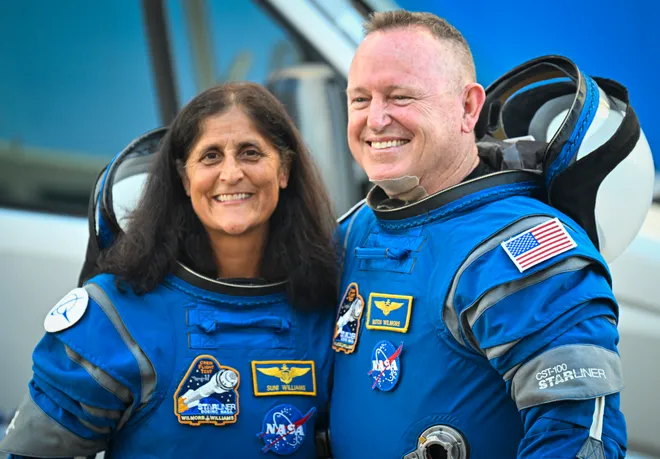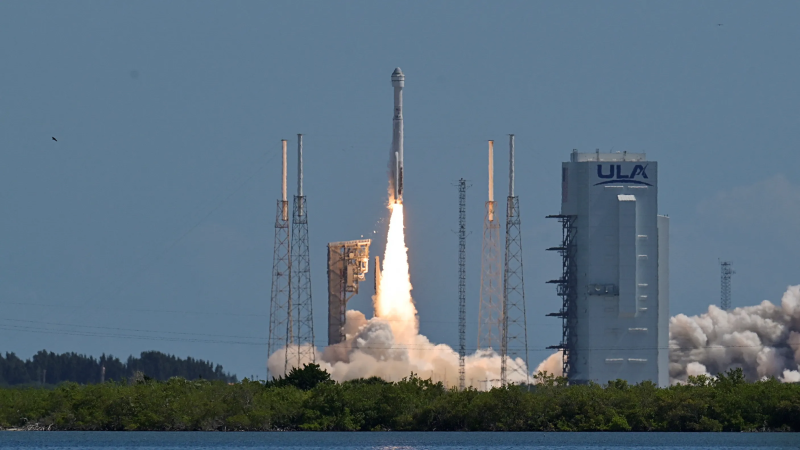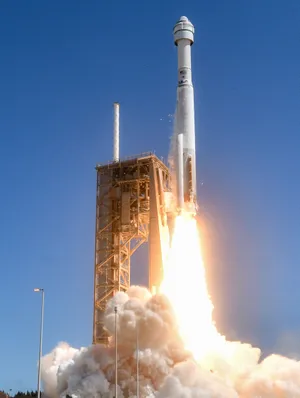Starliner astronauts say they're 'comfortable' on space station, return still weeks away
Veteran NASA astronauts and former Navy test pilots Barry "Butch" Wilmore and Sunita "Suni" Williams are "comfortable" remaining in space for a few more weeks, they said in an update with NASA on Wednesday.
NASA provided an update on the Boeing Starliner and its crew via telecast Wednesday afternoon, addressing delays that have turned a week-long trip into a 35-day and counting stay. According to the organization, Wimore and Williams may stay at the International Space Station (ISS) until later in the summer.
Scientists and engineers are working through testing to better understand and resolve issues that occurred during Starliner's launch and flight last month, including some misfiring thrusters and helium leaks. The testing is expected to conclude by the end of the week.
"I think we're really working to try to follow the data and see when's the earliest that we could target for undocking and landing," said Steve Stich, manager of NASA’s commercial crew program. "I think some of the data suggest optimistically maybe it's by the end of July but we'll just follow the data each step at a time and at the right time figure out when the right undock opportunity is."
While teams are looking to have Wimore and Williams depart from the space station before a crew turnover in mid-August, Starliner has been deemed safe to return to Earth at any time in an emergency situation. Currently, the ship is considered capable of returning its crew safely if they had to evacuate the space station on short notice.
Butch Wilmore and Suni Williams check in from space
Speaking in a separate press conference streaming live from ISS on Wednesday, Wilmore and Williams said they're "not complaining" about spending more time away from Earth.
"We are having a great time here on ISS," said Williams. "Butch and I have been up here before and it feels like coming back home. It feels good to float around, it feels good to be in space and work up here with the International Space Station team. It's great to be up here so I'm not complaining, Butch isn't complaining that we're here for a couple extra weeks."

And while the idea of being up in space longer than initially planned may sound scary to some, Wilmore and Williams are more than confident in the Starliner, its team, and their ability to get back home safely.
"We're absolutely confident (it'll get us back safe)," said Wilmore.
'Let's put some fire in this rocket':Crewed Boeing Starliner finally launches from Florida
When is Starliner coming back?
The Starliner's return to Earth has been repeatedly delayed since its initial planned reentry no later than a week after launch. It was then pushed to no earlier than June 18, then June 22, then June 25.
Now, Starliner and its crew aren't anticipated back until the end of July at the earliest.
The changes were partially due to the crew staying longer to better prepare the Starliner for the "long-term goal of having it perform a six-month docked mission at the space station," Stich said in an earlier June announcement. NASA also later mentioned spacewalks, data collection and the completion of further testing as reasons for the delay.
“We are taking our time and following our standard mission management team process,” said Stich in a June 21 update. “We are letting the data drive our decision-making relative to managing the small helium system leaks and thruster performance we observed during rendezvous and docking."
When it is time for Starliner to return, it will land in New Mexico. Starliner will "descend under parachutes to land in the desert grounds of White Sands," according to Boeing. After slowing to about 4 mph, airbags attached to the bottom of the spacecraft will deploy and soften its landing.
"The landing will mark the first time an American capsule has touched down on land with astronauts aboard," the company said in the release.
"I feel confident that if we had to, if there was a problem with ISS, we could get in our spacecraft and we could undock, talk to our team and figure out the best way to come home," Williams said in the virtual conference on Wednesday. "We've practiced a lot so I have a feeling, I have a real good feeling in my heart that this spacecraft will bring us home no problem."

What is the Starliner crew doing in space?
What have the astronauts been doing all that extra time in space? Quite a lot, actually, starting right from launch.
"Launch was spectacular, I mean truly amazing," said Wilmore, noting that the spacecraft performed "unbelievably well" and with "amazing" precision.
The second day after launch, said Wilmore, the loss of function in two RCS jets made handling noticeably different but, thankfully, the pair had practiced and been certified for manual control. They manually took over the ship for about an hour while teams on the ground troubleshot and got the jets back.
Once landing at ISS, the two integrated in with the exiting crew. They are fully certified for all aspects of life aboard the space station, said Wilmore, including spacewalks, operating technology and performing maintenance, which they have done "a lot of."
"That's part of living here, you gotta keep that space station going," said Wilmore.
The pair have also gotten to participate in a lot of scientific experimentation, according to WIlliams. From gene sequencing to using a 3D-printed moon microscope, they are keeping busy as temporary members of the ISS crew. More testing will be done on the Starliner's functions and how to optimize them both before, during and after undocking as well.

Starliner launches after delays
Wilmore and Williams launched into space on June 5 after several last-minute scrubs delayed the plans.
The inaugural crewed flight of Boeing's CST-100 Starliner, meant to compete with the likes of Elon Musk's SpaceX spacecraft, was waylaid by a series of technical issues. It began on May 6, the original launch date, when trouble with a valve in the rocket's upper stage forced the mission to be scrubbed.
The team was able to replace the valve, but then engineers encountered another obstacle: a small helium leak in Starliner's service module. That issue caused additional delays until it finally lifted off.
Additional helium leaks in the Starliner's propulsion system were later found after launch. During a media teleconference in late June, Stich, manager of NASA’s commercial crew program, said five leaks had been discovered since Starliner docked at ISS.
The valve that went faulty during launch also did not come back online when the crew test-fired the spacecraft's thrusters. The crew did not try to test-fire the defective valve and they don't plan to use it during the return flight "out of an abundance of caution," according to Stich.
Still, the craft safely navigated to the International Space Station, docking autonomously the following afternoon on the forward-facing port of the ISS's Harmony module.
Contributing: Eric Lagatta, Jonathan Limehouse and Natalie Neysa Alund, USA TODAY.
Disclaimer: The copyright of this article belongs to the original author. Reposting this article is solely for the purpose of information dissemination and does not constitute any investment advice. If there is any infringement, please contact us immediately. We will make corrections or deletions as necessary. Thank you.





